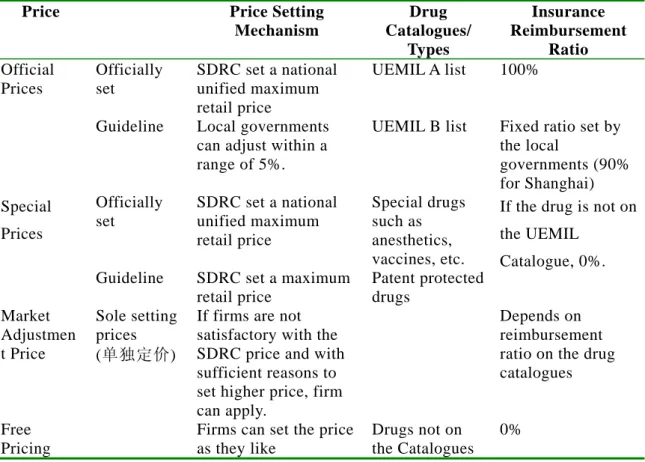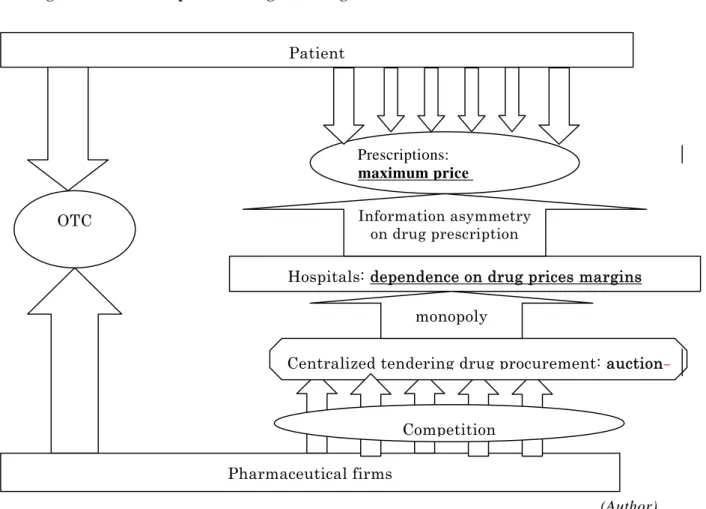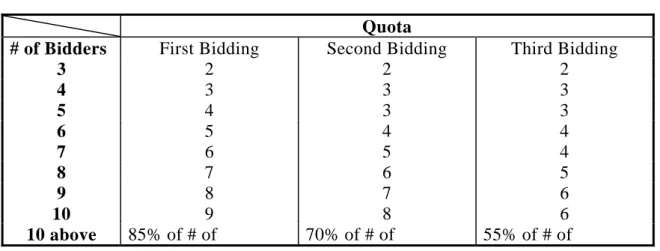Part I Demand and Institutions: The Industry Environment in China. Chapter 2 Institution on Pricing
権利 Copyrights 日本貿易振興機構(ジェトロ)アジア
経済研究所 / Institute of Developing
Economies, Japan External Trade Organization (IDE‑JETRO) http://www.ide.go.jp
シリーズタイトル(英 )
ASEDP
シリーズ番号 75
journal or
publication title
Pharmaceutical Industry in China‑Intellectual Property Protection, Pricing and Innovation‑
page range [23]‑28
year 2007
URL http://hdl.handle.net/2344/00015890
Chapter 2
Price Setting Institutions
In China, the price of drugs had been kept low until the mid 1980s so that basic medical care would be affordable for the general public. The medical care system was decentralized due to the progress of fiscal reform in China. Fiscal reform requires the local government to be responsible through their budget for the social security system. Thus, fiscal subsidies for the hospital and healthcare sector are limited, and as a result they are also required to operate by means of their own revenues. In this way, since the middle of the 1980s, the prices for medical services were adjusted to compensate for the operating costs of the healthcare sector.
2.1 The Principles of Price Setting
The current price setting mechanism in operation has following principles: 1) the State Development and Reform Committee (SDRC) has set a price cap on the retail price of drugs in the medical drug catalogues. 2) The price margin rule between forms of drug (差比价格规则). The SDRC also set a price ratio among forms of drug, using a normal tablet as a reference. 3) However, patented drugs are free to have the maximum retail price set, being independent of government price regulations (sole setting price: 单独定价).4) Auction is employed in the central tendering system of drugs at provincial level. The firms are faced with duplicated price controlling mechanism.
2.1.2 Price Cap by the SDRC
From 1980 to the present day, the governments have controlled every step of a drug’s pricing: the manufacturer’s shipment price, the wholesale price and the retail prices. Currently, the SDRC sets official prices based on the “Announcement on Official Price Setting Mechanism on Pharmaceuticals” promulgated in 2000.
That announcement laid out the following “cost plus” pricing formula:
Domestic retail (maximum) official price = Wholesaler’s price + 15%
margin
Wholesaler’s price = Manufacturer’s shipment price + 15% margin
Manufacturer’s price = Production cost + Sales fee + 5% Sales margin
This pricing formula is applied for the “official prices” and “special prices”
categories in Table 8, which shows the current pricing system of pharmaceuticals in China.
Table 8: Retail Drug Price Setting Mechanism by Purchasers
Price Price Setting Mechanism
Drug Catalogues/
Types
Insurance Reimbursement
Ratio Official
Prices
Officially set
SDRC set a national unified maximum retail price
UEMIL A list 100%
Guideline Local governments
can adjust within a range of 5%.
UEMIL B list Fixed ratio set by the local
governments (90%
for Shanghai) Special
Prices
Officially set
SDRC set a national unified maximum retail price
Special drugs such as anesthetics, vaccines, etc.
Guideline SDRC set a maximum retail price
Patent protected drugs
If the drug is not on the UEMIL
Catalogue, 0%.
Market Adjustmen t Price
Sole setting prices (单独定价)
If firms are not satisfactory with the SDRC price and with sufficient reasons to set higher price, firm can apply.
Depends on
reimbursement ratio on the drug catalogues
Free Pricing
Firms can set the price as they like
Drugs not on the Catalogues
0%
(Source) Japan Pharmaceutical Manufacturers Association, Information on China’s pharmaceuticals (in Japanese) (Note) UEMIL: urban employment medical insurance
2.2 Auctions Through the Centralized Tendering Drug Procurement Policy
In addition to the SDRC’s price control on the medical insurance drug catalogue, there is another mechanism relating to drug prices: the Centralized Tendering Drug
Procurement Policy, which operates at the provincial level. In 1999, centralized tendering drug procurement was initiated in order to overcome “high drug prices and corruption.” First, the government sector expected to reduce drug prices by monopolizing the purchasing power of hospitals toward pharmaceutical firms and utilizing an auctioning mechanism. Secondly, by utilizing these auctions, the government expected to open up the drugs’ procurement process.
It is true that by monopolizing both purchasing and auctions, you can expect to reduce the procurement prices of drugs. However, you cannot say that it reduces the retail prices for patients. As we can see in Figure 2, the hospital and physician have, by their nature, an information advantage over the choice of drugs, and thus they have the power of monopoly over patients. Furthermore, in China, hospitals greatly depend upon the drug price margin, and thus they prefer to prescribe expensive drugs. As long as this factor exists, a reduction of a drug’s procurement price will only increase the profit margin of hospitals, and will not reduce that drug’s retail price. In addition to this problem of hospitals’ incentive and motivation, the situation has become even more complicated as several price regulations regarding drugs are duplicated: the SDRC sets the maximum retail price and official margin, but on the other hand, the provincial government requires to that even lower prices be bid in auction.
The pharmaceutical industry has continued to oppose this method of centralized procurement, and 13 pharmaceutical associations sent a letter to the government requesting that they halt this mechanism. They claim that, given the highly competitive situation in the pharmaceutical industry and hospital’s high dependence on the drug price margin in China, the current institutions are only strengthening the power of monopoly that hospitals have over suppliers.
Furthermore, the current drug procurement scheme pays much less attention to the actual quality of drugs. We will analyze later what kind of situation would presumably occur under the current setting.
Regarding the retail price cap, the SDRC has started to aggressively reduce the official price. From 1997 to 2007, the SDRC consecutively implemented a drug price reduction 24 times. In May 2007, they announced that they had completed reductions on 1500 types of drugs on the drug catalogue controlled by the central government.
Figure 2: Duplicated Drug Price Regulation
Pharmaceutical firms Patient
Hospitals: dependence on drug prices margins Prescriptions:
(Author)
2.3 Case Study: Guangdong “Sunshine” Drug Procurement Scheme
At the end of 2006, Guangdong Province announced plans to implement a new style of drug procurement auction called the “Guangdong Sunshine Drug
Procurement Scheme.” In 2007, the new method of auctioning requires the auction to take place on the Internet. The procedure for the auction is as follows:
(http://www.gdyyzb.cn/bpportal/Article.asp?articleid=2103).
Step 1: Set the maximum limit price. For the officially-priced drugs, this refers to the official price – 15% hospital margin. For the market adjustment price, take the lower price of the following two: either, 75%
(from high to low) of the price for the minimum unit in that category (75%
maximum price OTC
Centralized tendering drug procurement: auction Information asymmetry
on drug prescription
monopoly
Competition
bulk line price), or 75% (from high to low) of the price for that category where the number of bidders is the largest.
Step 2: Set up the bidding category by quality. For the official price, follow the official price drug quality category. For the market adjustment price, classify into 1) Patented drug, 2) Expired patent drug, 3) GMP drug.
Step 3: Bidding
(1) Preliminary bidding. If the number of the bidders is less than 3, move to the price negotiation process. If there are more than 3 bidders, start the first round of bidding.
(2) Price negotiations are 1) negotiation with the experts, 2) voting by the experts, 3) counter-offers on a price by the experts.
(3) The first round of bidding. If the number of bidders is less than 10, the bidder with the highest price is eliminated. The rest will move on to the second round of bidding on the second day. If the number of bidders is 10 or more, the 15% with the highest bids are eliminated. If number of bidders is reduced to the quota (see Table 9), the remaining producers will be put on the list.
(4) The second and third rounds of bidding. Repeat the bidding following the same procedure as above.
Step 4: The hospital will select the drug and supplier from the suppliers selected by the above procedure, and make a contract of supply.
Table 9: Rules of Bidding Selection
Quota
# of Bidders First Bidding Second Bidding Third Bidding
3 2 2 2
4 3 3 3
5 4 3 3
6 5 4 4
7 6 5 4
8 7 6 5
9 8 7 6
10 9 8 6
10 above 85% of # of 70% of # of 55% of # of
preliminary bidders preliminary bidders preliminary bidders (Source) Procedures of the Guangdong Drug Procurement Sunshine Procurement
Scheme. (http://www.gdyyzb.cn/bpportal/Article.asp?articleid=2103)
Under this scheme, competition via auction will reduces prices to the minimum level that the manufacturers can offer. This is not new for the generic manufacturers. As the number of bidders for generic drug was large, they have already faced competition via auction. The new scheme will have more of an impact on drugs in the monopolized category, where only 2 or 1 bidders appear. In this category, the drugs can often be priced however the firms like, but now, under the new scheme, prices will be suppressed either through discussions with experts, or by voting or counter offers on the price, even if the auction will not take place because the number of competitors is limited by the nature of the patented drugs.
However, there is no principle on the price negotiation process (Step 3 (2)).
The Guangdong case is a model for the new model of auctions. Following Guangdong, Fujian Province is about to implement auctions under a similar model.
Here, the organizer of the auctions has announced that their maximum price should be 20% lower than the results of Guangdong’s bidding. Although the SDRC announced that they had completed the reduction of the retail price cap, he reduction of procurement prices through auctions will continue for a while.
References:
Japan Pharmaceutical Manufacturers Association, Information on China’s pharmaceuticals (in Japanese).


